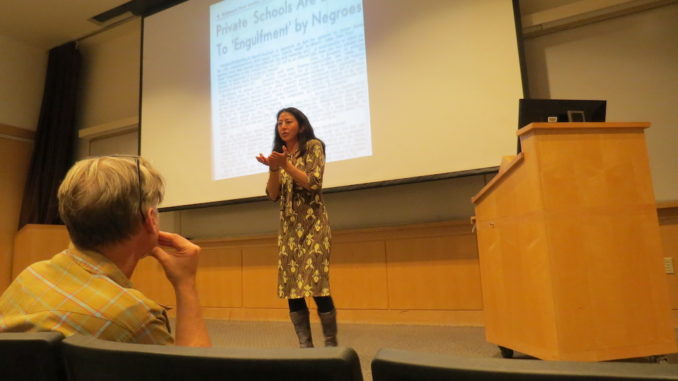
By Amelia Eichel
Assistant Professor of History Reiko Hillyer presented on Oct. 24 in the first installation of the Opposing White Supremacy Speaker Series put on by the Ethnic Studies Department. In this presentation, Hillyer provided historical context for the resurgence of White Supremacy and Neo Nazi rallies in the U.S. She argued that post-Civil War depictions of Confederate generals and soldiers as heroes changed the narrative of the war allowing Confederates to fortify racial power dynamics in American economic and social structures.
With the resurgence of white supremacist rhetoric in the media, concern for the safety of people of color has risen in liberal institutions such as Lewis & Clark.
“We created this series to talk about white supremacy from a clear perspective that we are against it,” Professor of History and Director of Ethnic Studies Elliot Young said. “We are trying to understand its historical roots and how to combat it.”
Hillyer’s presentation, “Trouble in Charlottesville: Confederate Memorialization and its Legacy,” provided evidence of the historical roots of white supremacy in the U.S. Her presentation consisted of many examples of statues commemorating Confederate generals and soldiers in the South.
“Confederate iconography came long after the Civil War,” Hillyer said. “It was part of the counter-revolution to Reconstruction.”
Hillyer explained that Reconstruction was the attempt to repair the south after the devastation of war and to give African Americans citizenship and equal rights.
The equal rights aspect of Reconstruction was met with strong resistance from ex-Confederates. After slavery was abolished, white southerners wanted to regain power over African Americans which lead to lynching and set the foundation for Jim Crow laws.
Another act of resistance to Reconstruction was the attempt to rewrite the narrative of the war. This is where Confederate monuments come into play.
“The Myth of the Lost Cause became the dominant narrative in the South and the North was complicit in it,” Hillyer said. “This is the idea that the Confederates heroically tried to defend their way of life from being eradicated by the Union.”
“American leaders in both the North and the South began referring to the war as ‘a war of brother against brother,’” Hillyer said. “When the white people in the North and the South united after the Civil War, they did so at the expense of black people. They seemed to forget that this was a war against slavery in the South.”
Hillyer argued that the depiction of Confederate generals and soldiers in monuments as heroes throughout the South was integral in spreading this false narrative. She and many students at the presentation said that they believe these statues should be taken down and replaced with unifying monuments.
The effects that white supremacy has on white people as well as people of color was also one of Hillyer’s main concerns.
“White supremacy is just as much about which whites are superior as it is about silencing people of color,” Hillyer said.
“I thought it was interesting that Reiko (Hillyer) made an explicit effort to bring class into her picture of white supremacy,” Lucas Martinez ’20 said. “I’m still grappling with that and I am not entirely sure how I feel about that intellectual move but it was definitely provoking.”
Hillyer explained why she thinks it is important to include class as well as race in the discussion of white supremacy.
“You miss half the story if you don’t consider the role of class in the politics of white supremacy,” Hillyer said. “It shrinks the political power of people of color as well as white people.”
The violence that occurred in August in Charlottesville, Virginia was the reaction of White Supremacists to a statue of Confederate General Robert E. Lee being taken down. Hillyer’s presentation explained the history behind these confederate monuments and why they are so important to white supremacists in their effort to gain economic, social and cultural power in America.
“I didn’t know a lot of the background history of the Civil War but this presentation made me want to know more about the history of white supremacy in America,” Cassidy Keyes ’20 said. “I definitely want to go to the next talk in this series.”
Subscribe to the Mossy Log Newsletter
Stay up to date with the goings-on at Lewis & Clark! Get the top stories or your favorite section delivered to your inbox whenever we release a new issue.

Leave a Reply